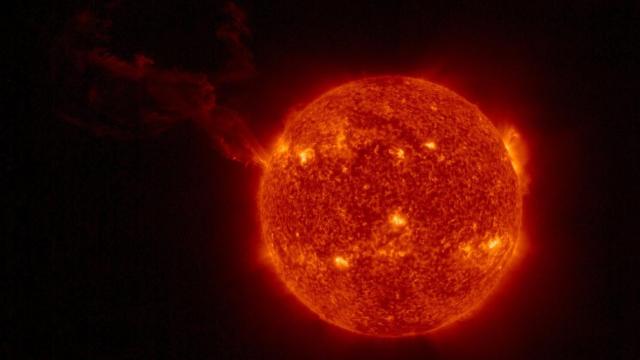The Solar Orbiter spacecraft had a front-row view this week of the Sun giving out an unusually large belch, resulting in a one-of-a-kind image.
Solar Orbiter observed the solar prominence, or filament, on February 15, according to a European Space Agency release. Solar prominences are clouds of solar gas held above the surface of the Sun’s magnetic field, and they often appear as gigantic looping structures that last for days or even weeks. These events can result in coronal mass ejections (CMEs), in which expelled gas races out through the solar system. If directed at Earth, CMEs can mess up our technologies — like newly launched satellites.
Thankfully, this ejection was not directed toward Earth. Quite the opposite, actually. The view from Solar Orbiter, a joint mission of NASA and ESA, suggests the filament originated on the Sun’s far side from the perspective of the spacecraft.
This particular solar prominence was a whopper, and it can be seen reaching out for at least 3.5 million kilometres, according to the ESA. And in fact, ESA says it’s “the largest ever event of its kind to be captured in a single field of view together with the solar disc,” an achievement that opens up “new possibilities to see how events like these connect to the solar disc.”
The eruption was also detected by BepiColombo’s radiation monitor, which picked up juiced readings of electrons, protons, and heavy ions. The ESA/JAXA spacecraft is currently in the vicinity of Mercury’s orbit. The SOHO spacecraft caught the eruption as well, but from the first Earth-Sun Lagrange point. Unlike Solar Orbiter, SOHO, a collaboration of ESA and NASA, uses a device called an occulter to block out the Sun’s glare, resulting in a large black dot at the centre of the image.
Launched in February 2020, Solar Orbiter is using its 10 onboard instruments to capture unprecedented close-up views of the Sun. The probe used its Full Sun Imager (FSI) of the Extreme Ultraviolet Imager (EUI) to capture this unique perspective of the Sun and its newly launched filament.
Daniel Müller, a Solar Orbiter project scientist, said the EUI/FSI observations showed the prominence material stretching out for a distance equal to five times the radius of the Sun, “and it can be traced much further out in SOHO/LASCO coronagraph data,” as he explained to me in an email. Prior to the eruption, the “prominence could neither be observed by Solar Orbiter nor from near-Earth because it was on the Sun’s far side, so we do not know what the prominence’s pre-eruption length was,” he added.
As its name implies, the Full Sun Imager can capture views of the entire solar disk, and it will continue to do so even when Solar Orbiter makes its next perihelion, or closest approach to the Sun, on March 26, when it will come to within 0.3 times the Sun-Earth distance.
Scientists will keep a close watch on this solar prominence using the aforementioned tools, as well as NASA’s Parker Solar Probe. It’s great that now we have so many eyes on the Sun, as it’s increasingly important for us to understand the processes behind these dramatic stellar events. That way, we’ll be better able to predict the effects of these blasts when directed us.
